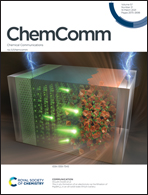Difluorocarbene-based cyanodifluoromethylation of alkenes induced by a dual-functional Cu-catalyst†
Abstract
Although cyanofluoroalkylation has received increasing attention, a toxic cyanation reagent is usually required. Herein, a Cu-catalyzed difluorocarbene-based cyanodifluoromethylation of alkenes with BrCF2CO2Et/NH4HCO3 under photocatalytic conditions is described. BrCF2CO2Et and NH4HCO3 serve as a carbon source and a nitrogen source of the nitrile group, respectively, avoiding the use of a stoichiometric toxic cyanation reagent. The Cu-complex plays a dual role. It is not only a photocatalyst, but also a coupling catalyst for the formation of a C–CN bond.



 Please wait while we load your content...
Please wait while we load your content...